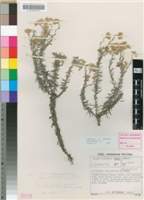Origin of name:
a = without (Greek)
-thrix = hair (Greek)
folium / -sus / -a = leafy
Diagnostic characters:
Leaves in 'groups' or clusters, margins rolled inwardsSmall compact to open inflorescences with many small headsOff-white / cream coloured bracts
Description:
Bushy perennial herb up to c. 450 mm high, stems woody, young parts thinly appressed greyish-white woolly, very leafy, primary leaves often subtending very dwarf lateral shoots, making the leaves look fascicled. Leaves mostly 10�40 x 1�5 mm, those on the dwarf shoots sometimes smaller and usually very narrow, linear, linear-lanceolate or oblong-lanceolate, apex acute, base half-clasping, very shortly decurrent, margins more or less revolute, upper surface thinly cobwebby, soon glabrescent, lower surface thinly white tomentose. Heads heterogamous, oblong-campanulate, c. 4 x 3 mm, few to many in compact corymbose panicles, terminating the branches. Involucral bracts in 5�6 series, graded, loosely imbricate, tips subacute, opaque white in the inner series, crisped, innermost about equaling the flowers, scarcely radiating. Receptacle shortly honeycombed. Flowers 16�30, 6�13 female, 8�17 homogamous. Achenes 0,75 mm long, with myxogenic duplex hairs. Pappus bristles many, equaling corolla, scabrid, bases cohering by patent cilia.
Flowering recorded in all months.
Distribution:
Grows in grassland or open woodland on sandy or shaly soils, and will invade overgrazed or eroded areas, and roadsides. Ranges from the Lowveld in Mpumalanga and Swaziland to Tongaland and coastal Zululand, penetrating westwards into KwaZulu-Natal in the basins of the Pongola and Tugela Rivers.
Savanna and Grassland Biomes.
Notes:
H. athrixiifolium is frequently confused with H. rugulosum, but that species produces simple or subsimple stems from a creeping stock, rarely has dwarf axillary shoots, and the fimbrils on the receptacle much exceed the ovaries. However, H. athrixiifolium is closely allied to H. rosum, from which it is scarcely distinguishable in habit, foliage and size and shape of the heads. But the tips of the involucral bracts are always much crisped in H. athrixiifolium, while they are nearly always smooth, rarely slightly crisped, in H. rosum.
Taxonomy:
Literature:
Helichrysum athrixiifolium (O. Kuntze) Moeser in Bot. Jb. 44: 281 (1910); Hilliard, Compositae in Natal 199 (1977).
Type:
KwaZulu-Natal, Colenso, O. Kuntze 1337 (W, holo.; K, iso.).
Synonym(s):
Gnaphalium athrixiifolium [O. Hoffm. ex] O. Kuntze, Rev. Gen. 3: 150 (1898).
Vouchers:
Codd 4751 (NU; PRE); Compton 28988 (PRE); Hilliard & Burtt 8586 (E; K; MO; NU; S); Strey 5439 (NU, PRE); Wright 151 (E; NH; NU).

